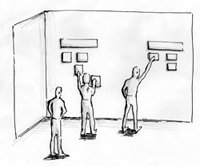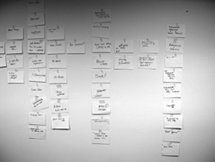Processing the Results of Your Innovation Game The primary goal of processing the results is to transform what your customers did and all that your team observed into a useful action plan. Following are four key steps in this phase: 1. | Capture and process all customer artwork.
| 2. | Capture and process all observer cards.
| 3. | Conduct a brief retrospective of the event so that you can improve it for the next time.
| 4. | Prepare two reports: an internal report that details the actions you will take and an external report provided to customers, letting them know what you've learned.
|
A common mistake in this phase is to underestimate the time required to process game results. One team we worked with had allocated only 8 person-hours (2 people for four hours) to process the result. They needed more than 80! A better rule is to allocate roughly 40 person-hours per game. Step One. | Process Customer Artwork
Customer artwork refers to the various artifacts that customers create while playing an Innovation Game. These range from simple easel paper or 5"x8" cards taped to walls to product boxes describing their ideal product. This section covers the basics, and Part Two details how to process the results of each game.
The most important guideline is to photograph everything generated by customers so that you will have a direct and permanent record of the artwork. Photos should be taken immediately after finishing the game to minimize the risk that something will be accidentally thrown out by an overly eager cleaning crew. These photographs augment and enhance the photographs created by the "Bad Wedding Photographer" during the event. These photographs should be taken with relative care because you will be using them during post processing activities and for sharing with your internal team. You may also share some of these with the customers who participated in the game, so they should be as high quality as you can make them, including using image-editing software to enhance the images.
Some of the games generate results that should be shared directly with product teams. For example, Show and Tell, Product Box, Spider Web, and Start Your Day are all games that create artwork that should be directly shared with product teams. Instead of telling them about what customers did in your final report, you can show them what customers created. Doing so fosters a strong incentive to act on the information generated by your customer.
| | | Step Two. | Process Observer Cards
During the game, observers were writing down their observations, ideally one observation per card. In this phase of the processing, you'll mine these observations for actionable patterns. The process is relatively simple and should be done as quickly as possible after the event, with all observers present. It is helpful if the facilitator or planner leads this process, because it allows the observers to concentrate on sharing and explaining their observations.
Review each card to make certain it contains one distinct observation. If a card contains multiple observations, create new cards for each observation, adhering to the guideline of one observation per card. Tape all cards on the wall. Figure 1.22. Place the Observer Cards on the Wall  Have all the observers review the cards, organizing them into groups as they deem appropriate. A card can be placed into multiple groupsjust create a copy of the card and place it into both groups. You'll often find that several observers captured the same comment. When facilitating, I like to keep each individual card, whereas other facilitators put a number on the card indicating the number of observers who captured the same comment and dispose of the duplicates. Either way works just fine. Figure 1.23. Organize the Cards into Groups as Needed  As groups of cards solidify, create a special card that captures the important concept that unifies the cards within that group. For example, suppose that when playing Start Your Day several observers noted that customers use your product very differently in the fall than in the spring, summer, or winter. You might create a group heading card called "Fall" and organize cards under this heading. Keep this process going until observers stop moving cards around and there are no more groupings. Some observations may not fall into any groupthat is okay. Not every card has to be put into a group.
Pause here and photograph the results. This will ensure that you have a record of the observer comments in the base categories that they created. After you've got everything photographed, keep going.
Figure 1.24. The Final Observer Note Cards 
The facilitator and/or planner hands each observer an index card and asks the observers to quietly write down the top three things that they observed during the game. The facilitator then collects these and reviews them with the entire team. Quite often, the top three items will have surprising similarities among observers. In one event, five observers all identified the same items.
The facilitator should make one final pass over all the observations, making certain they understand each of the groupings as well as all the individual observations. The observations are then coded into a spreadsheet under the groupings described earlier for easy reference, searching, and sharing. It is not important to record which observer generated what observation.
| Step Three. | Retrospective
A brief retrospective of the event should be held, ideally when the entire team is present. Although there are many ways to conduct a retrospective, a simple format consisting of the following questions is usually sufficient:
What worked so well that we should do it again? What worked so badly that we should never do it again? What should we try changing?
| | | Step Four. | Prepare Reports
There are two reports that must be prepared. They are equally important, for different reasons. The first report is designed for internal distribution. A simple organization, such as that defined in Table 1.4, works well. The focus is on the action you intend to take and the necessary information obtained during the event that supports this action. The second report will be distributed to customers who attended the event. You should prepare the internal report first, because it almost always contains elements that you will want to include in your external report. Table 1.4 captures the critical elements of the internal report.
Table 1.4. Critical Elements of an Internal ReportSection | Contents |
|---|
Executive Summary | Recap of the motivations and goals of the project and the key learnings and recommended actions. Typically this is 1 to 3 pages. A few well-placed photos can do wonders. | Results for Each Game | Overview of each game played and the key results of each as described in Part Two. More photos of the event are useful here. | Retrospective Results | The summarized results of the retrospective. |
|
Start by Saying "Thank You!" The best way to start your customer report is to thank your customers for attending the event and providing you with their valuable insights. After you have thanked them, here are other items you might want to consider including in your customer report: Inviting them to attend the next event. Providing contact information for your team and/or other customers who attended the event. Asking them to provide further feedback on the event or to elaborate on the themes that you've heard. Asking them to provide other feedback on the event, such as the location or timing.
|
The primary purpose of the customer report is to let your customers know that you heard them, that you value their input, and that you will take action on the data acquired. The customer report can be as simple as a one-page summary or as elaborate as a detailed action plan that captures the results of the feedback. Timeliness is essential, and you'll find your customers would prefer a short report distributed within two weeks of the event to a longer report distributed four months later. If you really do intend a longer report and need extra time to create it, distribute a short one quickly, commit to a time frame for the longer report, and then complete the longer report before you promised. Make certain that everyone on your internal team who either attended the event and/or works with these customers is included in the distribution list, especially in professional organizations or business-to-business products, because people who work directly with customers get very nervous when information is sent to their customers without their knowledge or approval. |


